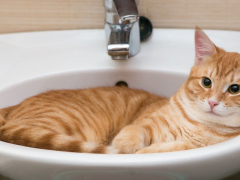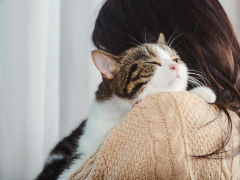
Jasper exhibits signs of fear and anxiety. Melina Grin / Cats.com
- Stimuli That May Motivate a Cat to Exhibit Unprovoked Aggression
- Reasons for Unprovoked Aggression Towards Humans, Kids and Other Pets
- Aggression Towards Humans
- Aggression Towards Dogs
- Aggression Towards Kids
- Aggression Towards Other Cats
- How To Address Unprovoked Aggression Towards Humans, Kids and Other Pets
- To Wrap Up
Unprovoked aggression in cats can manifest either suddenly or as a chronic issue. This behavior includes actions such as attacks, bites, and other violent actions intended to intimidate another individual or pet. It is a common behavioral concern we encounter in our practice, and it can lead to serious injuries. In severe cases, this aggression may result in cats relinquishing to shelters or even facing euthanasia.
This article examines common triggers and causes of unprovoked aggression in cats toward humans, dogs, children, and other cats and provides practical solutions for pet owners.
Stimuli That May Motivate a Cat to Exhibit Unprovoked Aggression
Here are the most common motivations that trigger unprovoked aggression in cats.
1. Medical Triggers
Pain and Discomfort
Sudden aggression in cats can be linked to pain or injury, often due to conditions like osteoarthritis, dental disease, or infections, leading to unexpected attacks.
Declawing
Declawing is common in the USA and Canada to prevent property damage. Still, a study found it’s linked to a higher likelihood of unwanted behaviors such as biting, excessive grooming, aggression, and inappropriate elimination.
Illnesses
Medical issues like hyperthyroidism, feline hyperesthesia, epilepsy, and neurological disorders such as cognitive decline can impact a cat’s emotional well-being and cause them to bite and swat erratically.
2. Behavioral Triggers and Types of Feline Aggression
The key behavioral triggers and categories of feline aggression include various psychological and environmental factors that influence individual behaviors and interactions. This article will elaborate on these factors below.
- Excessive restraint
- Fear and anxiety
- Predatory/play aggression
- Petting induced aggression
- Redirected aggression
- Territoriality
- Maternal hostility
3. Environmental Triggers
Changes in Environment
A sudden change in a cat’s living environment, such as relocating, rearranging furniture, or being placed in a vet hospital or boarding facility, can lead to stress and aggression.
Confinement
Cats thrive on adventure and detest being cooped up in tight spaces. When confined without easy access to their necessities—like food, water, and litter box—it can lead to annoyance and even aggression.
Moreover, countless cats spend time in shelters or catteries during their lifetime. Confinement can invoke high levels of psychological distress and aggression in adult cats.
Restriction To Hiding Spots
Cats require secure spaces to retreat when feeling stressed or threatened. Insufficient hiding spots or blocked access to these areas can increase anxiety and lead to malicious, aggressive behavior.
Reasons for Unprovoked Aggression Towards Humans, Kids and Other Pets

As observed, sudden cat aggression is often triggered by pain, with the cat becoming defensive due to fear of touch in a painful area or anticipation of discomfort from handling. Melina Grin / Cats.com
There are several reasons why a cat may exhibit aggression towards people and other pets without any apparent provocation. Let’s review the common reasons and the warning signs that a cat may be about to attack.
Aggression Towards Humans
1. Pain-Induced Aggression
As we learned, abrupt cat aggression is often linked to pain. This reaction may occur because the cat is afraid of being touched in an area that hurts due to an injury or anticipates discomfort from being handled. This response acts as self-defence, reflecting a natural survival instinct.
Medical conditions also decrease a cat’s tolerance for physical contact, making them more likely to display hostility due to heightened sensitivity. Watch for signs like crouched posture, flattened ears, changes in appetite, refusal to jump, hissing, hiding, or aggression inconsistent with normal cat behavior.
2. Excessive Handling and Restraint
Felines thrive with minimal handling and restraint techniques. Over-restraint can intimidate the cat, prompting escape attempts, and they may become aggressive if there’s no way out.
“Scruffing” is an outdated technique that involves firmly grasping the skin on the back of a cat’s neck. Some cat owners, shelters, and veterinarians still use this technique, mimicking how mother cats carry their kittens. However, scruffing adult cats can lead to immobility, as the restriction of movement often triggers fear. In some cases, this technique can increase a cat’s stress levels and manifest in assault.
3. Fear or Anxiety-Induced Aggression
Fear-induced aggression in cats occurs when they sense a threat to their safety. When faced with terrifying situations, felines try to escape or avoid them. If they cannot flee or suppress their fearful response, they may resort to spiteful defensive attacks.
Examples include being cornered at home, placed in a carrier, or taken to the vet. A cat mistreated by someone in the past may become aggressive when that person approaches. This may cause a cat to bite out of anxiety and fear, especially if it feels trapped. Such unprovoked attacks can alarm owners and discourage regular veterinary health checks.
It’s essential to be aware of warning signs such as bowed posture, hissing, growling, and spitting, as these behaviors can escalate to scratching and biting.
Cats can also develop fear-based aggression due to negative experiences in particular environments, such as shelters, or encounters with certain humans or situations.
4. Redirected Aggression
This violent behaviour occurs when a cat cannot access resources, maintain control over them, or defend its possessions and territory. The cat may express frustration toward its owner.
Common causes of redirected aggression in cats include seeing another cat outside through a window and being unable to chase it away because they are confined indoors. Additionally, if an owner picks up a cat during a fight with another cat, it can lead to redirected aggression. Furthermore, a cat startled by unexpected loud noises, like a fire alarm, may become agitated and express frustration inappropriately.
5. Petting-Induced Aggression
Gratuitous attacks during petting are common when a cat initially seeks social interaction but unexpectedly reacts with scratching or biting. Be attentive to warning signs, such as dilated pupils, tail swishing, attempts to move or walk away during a petting session, or suddenly grooming itself while stroking. Generally, cats prefer gentle, short strokes to high-intensity or heavy-handed petting. Furthermore, if a cat becomes overly relaxed, it may experience a conflict between pleasure and discomfort, resulting in sudden, aggressive movements.
6. Misdirected Predatory Aggression
Play aggression in cats is often characterized by stalking, chasing, and pouncing, commonly followed by quick attacks on human hands. This type of behavior typically develops when cats do not learn bite inhibition or if owners engage in inappropriate roughhousing with kittens. As a result, these kittens can become overstimulated and may scratch or bite as adults. Moreover, some cats may ambush their owners while they walk by, pouncing and swiping at their feet.
Additionally, a cat prevented from hunting or playing with suitable toys may direct predatory behavior toward moving objects, such as an owner’s arms and limbs. The cat’s excitement and actions can intensify if the owner suddenly moves or yells, leading to an increased bite reflex that can cause unintentional but serious puncture wounds.
Furthermore, boredom, lack of variety, absence of new experiences, and under or over-stimulation can also contribute to predatory and aggressive behavior in cats.
Aggression Towards Dogs

The most common cause of aggression is pain or illness, with fear also playing a role, particularly if a cat encounters unfamiliar dogs or wasn’t socialized with them as a kitten. cynoclub / Shutterstock.com
Various stressors can trigger a cat’s hostility toward a dog. The most common cause is pain or illness. Fear is another reason, especially if a cat encounters unfamiliar dogs or hasn’t been socialized with them during kittenhood. A cat may react aggressively when it feels threatened or cornered by a dog, especially if the dog is excitable and viewed as a threat.
Additionally, a cat’s aggression toward a dog can arise from frustration or anxiety due to a lack of attention from its owner or competition for resources. If a cat feels uneasy around a dog because of stress or other factors, it may use force to remove the canine from its environment. Furthermore, a cat might display antagonistic behavior if it believes a dog is invading its territory.
Aggression Towards Kids

Fear—often from limited early socialization—is a key reason some cats react negatively to children. Nataliabiruk / Shutterstock.com
Cats may show violence towards children for several reasons. One primary reason is fear, especially if the cat lacked socialization with kids early on. Children can be loud, move quickly, and behave unpredictably, which can frighten a cat. A feline without exposure to toddlers may not know how to interact with them and might hiss or bite to set boundaries.
As children grow and become more mobile, this can increase a cat’s anxiety. The cat may see the child as a source of stress, mainly if the youngster suddenly makes loud noises or tries to grab them, creating a negative association. Additionally, children’s unpredictable behavior, such as picking up a cat, can overwhelm the animal, leading to aggression as a defensive response.
If a child invades the cat’s personal space, the cat may feel threatened and view the child as an intrusion into its core territory. Some cats can also become overstimulated from too much petting, resulting in hissing as a signal that they need a break. Lastly, a cat with negative experiences with children may respond aggressively towards them.
Aggression Towards Other Cats

A cat reacts aggressively toward a companion due to unfamiliar scents and possible underlying illness or pain. Melina Grin / Cats.com
Unjustified aggression toward other felines can arise from a variety of factors. Undiagnosed illnesses or chronic pain, as well as the unfamiliar scent upon returning home after a veterinary stay, can cause a resident cat to act aggressively towards another cat.
Cats that haven’t been adequately socialized or experienced past trauma during their critical development periods may struggle with interactions with other cats, leading to misunderstandings and attacks.
A cat may exhibit redirected aggression toward another cat when an owner comes home wearing shoes and clothes that smell like a different cat. Another example occurs when a stressful event coincidentally happens while the cats are present, triggering defensive or offensive behavior in one of the cats. If the source of stress is not accessible, this aggression may be redirected toward the other resident cats.
Moving to a new home, undergoing significant renovations, or introducing a new cat can induce stress and malicious intimidation. Although less common, queens may exhibit maternal aggression to protect their kittens, particularly during the postnatal period. They may become more territorial and defensive around their offspring, showing ferocity toward other pets or unfamiliar individuals.
How To Address Unprovoked Aggression Towards Humans, Kids and Other Pets

Consider taking your cat for walks or increasing its outdoor time using a harness and leash in a safe environment. Melina Grin / Cats.com
The first step in addressing unprovoked attacks is to consult a veterinarian to rule out any underlying medical issues and identify the type of aggression your cat displays.
The next step is to determine the sources of your cat’s agitation and either minimize or eliminate these triggers.
Addressing Aggression Towards Humans
- Familiarize yourself with the warning signs of cat body language that can alert you to an impending bite or ambush.
- For pain-related issues, discomfort management options should include pain control, alternative therapies and avoidance of touching a cat’s painful body parts.
- If a cat’s belligerence stems from fear of aggression, it’s best to avoid direct eye contact and act as if the cat is invisible. This technique can help the cat feel more secure, allowing them to move freely around the home.
- If the cat’s assault results from being petted too much, avoid lengthy stroking sessions on sensitive areas like the belly, chest, or back.
- When your cat reacts aggressively to the scent of another cat on your hands or clothing, change your clothes and wash your hands before handling your cat.
- Please don’t attempt to comfort your cat when he is physically fearful; this may cause injuries and exacerbate his panic.
- Constructively address attention-seeking behavior.
- Provide structured interactions with new people.
- Redirect predatory behavior towards toys instead of limbs. Keep a few toys in your pocket and throw one away from your body before the cat attempts to nip at you.
- Use positive reinforcement by rewarding calm behavior with treats and praise. Avoid punishment, as it can increase fear and aggression.
- Boost your cat’s environment with interactive toys, puzzle feeders and training sessions to keep her mind sharp and prevent frustration from boredom and monotony.
- Introduce or increase outdoor time in a safe environment or invest in a Catio.
- If you are expecting guests and have a cat that displays territorial aggression, it is best to isolate the cat during their visit.
- Pheromone products, calming collars, or CBD oil can reduce stress and aggression.
- Work with a certified veterinarian or animal behaviorist to address behavioral issues and consider introducing supplements or medications.
Addressing Aggression Towards Dogs
- Keep the cat in a secure area, such as another room, to ensure safety.
- Reintroduce the dog to your cat gradually, starting with controlled interactions. Consider using a harness and leash for the cat and dog during these sessions. Reward relaxed behaviors in your cat during re-introductions and when in the same space.
- Supervise interactions between them, even in the same area, to prevent escalation of feline aggression. Likewise, monitor your cat’s body posture and intervene if they show early warning signs of hostility towards your dog.
- Ensure the cat has access to elevated areas and hiding spots where they can retreat and feel secure to minimise high arousal.
- Provide separate resting and feeding areas to avoid territorial disputes and minimize food aggression (elevated food areas for the cat).
- Ensure sufficient food, water bowls, bedding and toys to minimise resource competition.
- Do not force your cat to interact with a new pet. You may need to use desensitization and behavior modification techniques to reduce your cat’s anxiety.
- If the aggression is too severe, you may have to keep the cat and dog separated at all times.
Addressing Aggression Towards Kids
- Teach kids how to handle cats gently and respectfully and supervise all interactions between cats and small children until the cat is calm in their presence.
- Install a baby gate to separate your cat from your child. This occasionally will provide your cat with a time-out area and a relaxation zone.
- Ensure your cat has ample escape routes, hiding spots, and vertical space.
- Always reward your cat for relaxed behavior with treats and praise. If your cat displays warning signs of aggression, redirect it to a toy before an attack.
- If the cat fears the child, gradually desensitize it to their presence with short, supervised interactions, increasing the duration and intensity.
Addressing Aggression Towards Other Cats
- Separate feuding cats throughout the home and gradually reintroduce them to each other by swapping scents and having short, supervised meetings. Use the Feliway Friends diffuser to create a calming environment for the reintroductions.
- Attend to each cat’s medical, physical, and emotional needs while consulting with your veterinarian to manage their anxiety and stress.
- Provide sufficient, multiple resources (litter boxes, food bowls, water bowls, elevated hiding places and sleeping areas, and toys) to prevent competition, reduce irritability and negative emotions and increase a cat’s self-confidence.
- Relocate scratching substrates near entrances, beds, and feeding stations to provide suitable surfaces for marking in areas of potential competition.
- Ensure that all the cats in multi-cat households are neutered to minimize fighting.
- If accidental fights occur, harness and leash train those cats before re-introductions.
- For non-recognition aggression following vet visits or cattery stays, separate the cats into different rooms and reintroduce them from the beginning.
- To prevent redirected aggression, try to identify the source of stress and remove it if possible. If the trigger is another tomcat, draw down a curtain or place an opaque film on the window.
- To break up a fight, throw towels over both cats to separate them with a minimal chance of injury.
- To reduce maternal aggression and stress for the queen and her kittens, provide a quiet nesting site, and limit scent disruption.
- Start clicker and target training to teach cats new behaviors, which can help reduce tension between territorial and antagonistic felines.
- If cats have outdoor access, provide two separate entry and exit points through cat flaps or windows to avoid the risk of being blocked by assertive individuals.
- When introducing a new cat, many indoor cats fight. Therefore, providing controlled outdoor access can help reduce aggression and prevent future conflicts.
To Wrap Up
It is essential to consult with a veterinary behaviorist or a certified feline professional who can help identify the root cause of the unprovoked aggression and develop an effective management plan. Pet owners must be patient and consistent in following the management plan to prevent future attacks and ensure a harmonious and peaceful household.
-
Halls, V. (2020). ‘I’m not bad, I just do bad things!’: Reframing our thoughts on aggressive cats. ISFM International Congress (pp. 1-6). ISFM. Retrieved March 15, 2025
-
Moody CM, Mason GJ, Dewey CE, Niel L. Getting a grip: cats respond negatively to scruffing and clips. Vet Rec. 2020 Mar 28;186(12):385. doi: 10.1136/vr.105261. Epub 2019 Oct 5. PMID: 31586939.
-
Heath, I. R. (2016). Feline Behavioral Health and Welfare. St Louis, MO: Elsevier. Pg 16, 75-78, 192-193, 244, 293-294, 327, 346-375, 376-382 Retrieved March 05, 2025
-
JOUR, O'Hanley, Kristina, Pearl, David, Niel, Lee. 2021/02/01. SP 105251. Risk factors for aggression in adult cats that were fostered through a shelter program as kittens. VL 236 doi 10.1016/j.applanim.2021.105251. Applied Animal Behaviour Science
-
Helen Tuzio, T. E. (2004). FELINE BEHAVIOR GUIDELINES. (A. A. Practitioners, Compiler) USA: AAFP. Retrieved March 06, 2025
-
Moesta, A., & Crowell-Davis, S. (2011). Intercat aggression – general considerations, prevention and treatment. (D. o. Behavior Service, Compiler) Georgia, United States: University of Georgia. Retrieved March 18, 2025
-
Martell-Moran NK, Solano M, Townsend HG. Pain and adverse behavior in declawed cats. Journal of Feline Medicine and Surgery. 2017;20(4):280-288. doi:10.1177/1098612X17705044
-
Ramos, D. (2019). Aggression in multi-cat households. Journal of Feline Medicine and Surgery, 21, 221-233. Retrieved March 17, 2025







